Ok, you got a bag of this grain-like vegetable from the frozen food aisle, so here is everything you need to know about how to cook frozen cauliflower rice at home to get golden, tender, light and fluffy, grain-free ‘rice’ ready to serve in just under five minutes.
Check out these popular cooking options with or without oil; plus, I have included top tips on avoiding that dreaded soggy cauliflower rice and how to season it to perfection.
How To Cook Frozen Cauliflower Rice On The Stove?
The easiest way to cook frozen cauliflower rice is by frying it on the stovetop with just a little oil. All you need is a frying pan, wok pan, or skillet, and a splash of oil. I like to use avocado or olive oil, but any cooking oil would do.
To get a lovely buttery flavor, use clarified butter instead of oil.
How To Cook:
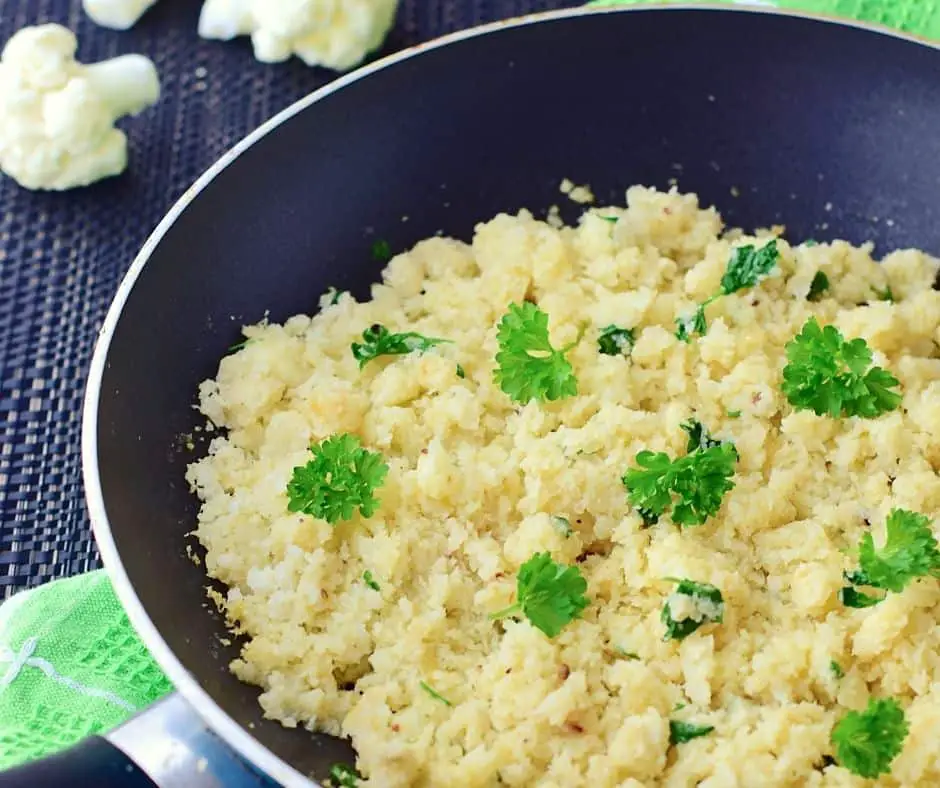
- Preheat 2-3 Tbsp oil in your pan for 1 minute.
- Add frozen cauliflower rice straight from frozen and cook on medium heat (break up any frozen cluster).
- Stir a couple of times to ensure even cooking. Sautéed for about 5 minutes till browned a little.
- Add a pinch of salt to serve and garnish with parsley.
Top Tip: To serve four people, use 5 cups of riced cauliflower. Once cooked, you will end up with about 4 cups.
How To Roast Frozen Cauliflower Rice In The Oven?
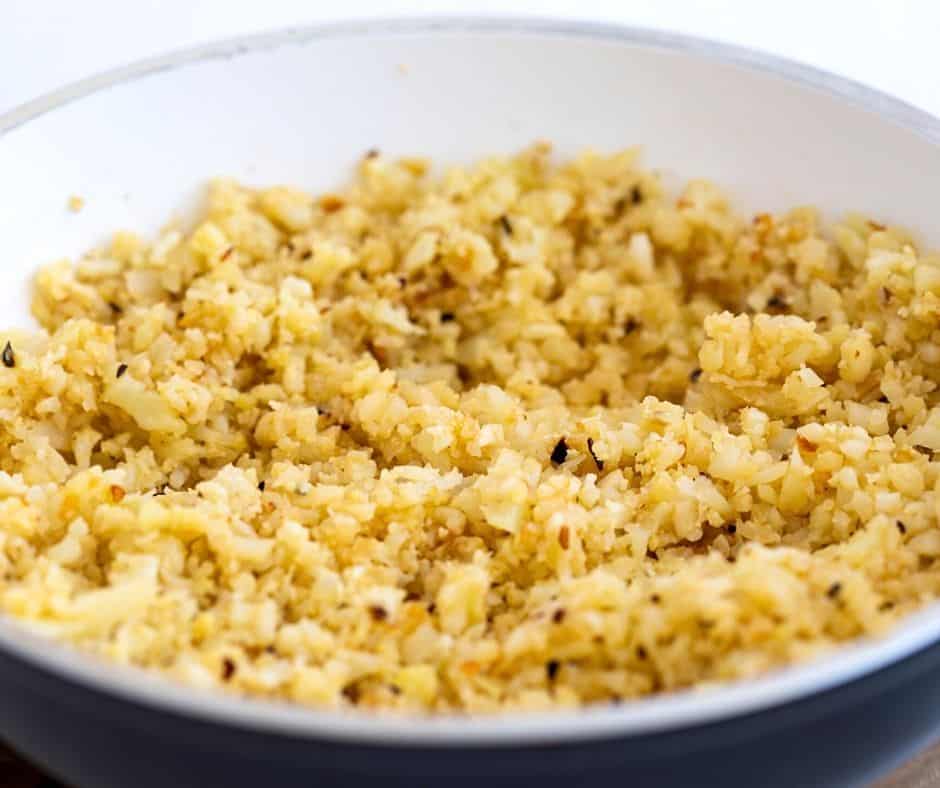
Alternatively, you could cook your frozen cauliflower rice in the oven. Although roasting it will take longer, it will be worth it for the deliciously crispy texture. You could even mix in broccoli rice for some additional nutrients and color.
How To Cook:
- Coat a large baking tray evenly with oil or cooking spray.
- Add the cauliflower rice to the tray with some fresh minced garlic and a drizzle with oil.
- Mix well.
- Spread it evenly over the baking tray and bake at 425°F (220°C).
- Turn the rice over with a large spoon after 10-15 minutes. Then cook for a further 10 minutes.
- Serve when evenly golden brown.
- Top with sea salt, grated Parmesan cheese (or another hard cheese for a vegetarian alternative or hemp seeds for vegan option), and fresh parsley (optional).
How To Cook Frozen Cauliflower Rice In The Microwave?
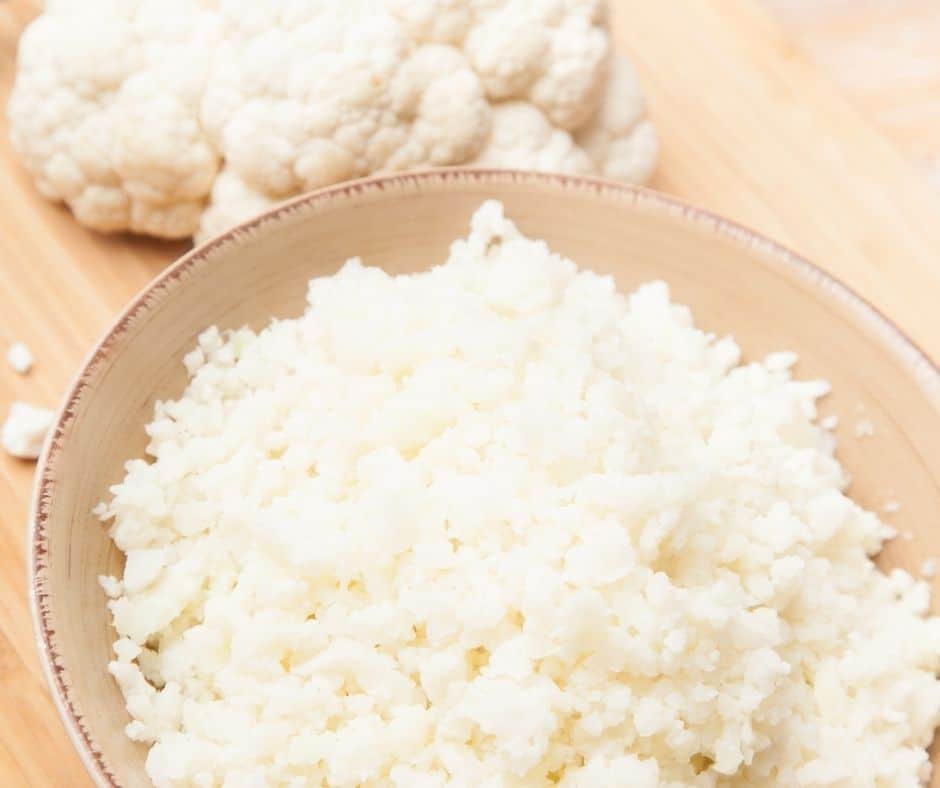
Cooking cauliflower rice in the microwave is not my favorite cooking method but is fast and doesn’t require any cooking oil. Cooking it in the microwave may give you a more soggy result compared to cooking it in the oven. However, sometimes this may be your only option if you are in an accommodation without full kitchen facilities.
How To Cook:
- Add four cups of frozen cauliflower rice to a large microwave-safe bowl with one-quarter cup of vegetable stock or water.
- Mix and cover the bowl with a microwave-safe plate.
- Cook on your microwave’s highest setting for 3 minutes.
- Check the rice and stir. You may wish to continue cooking to achieve a more tender result. Continue cooking on the highest setting in 30-second intervals.
- Season with salt and serve.
How To Steam Frozen Cauliflower Rice In The Oven?
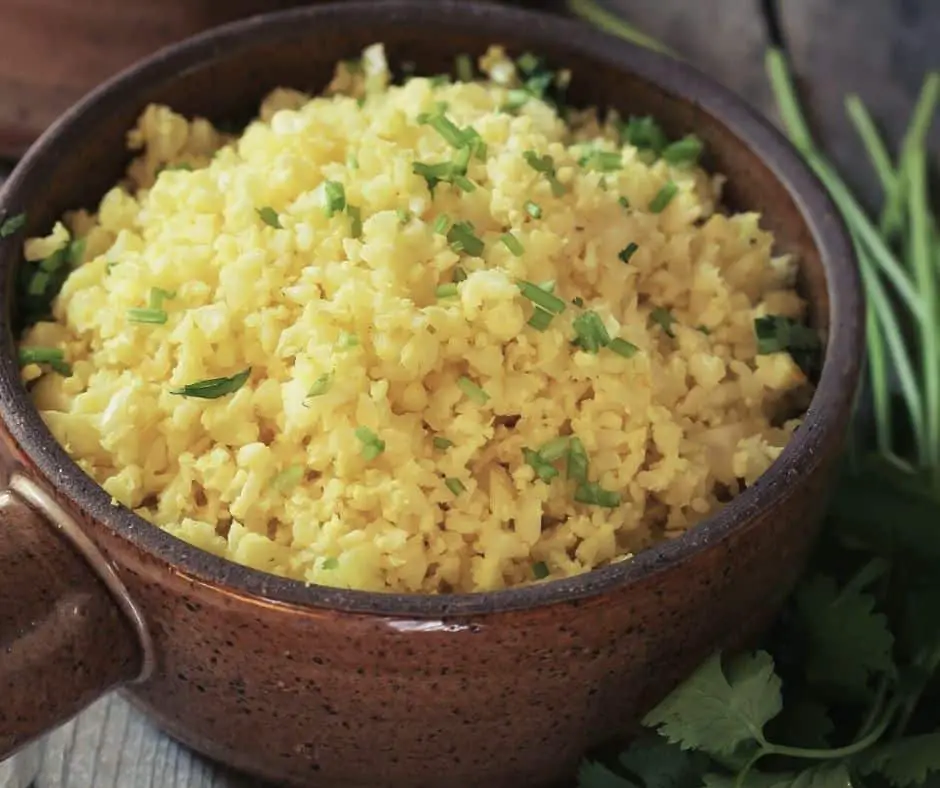
Although cooking with oil is recommended for maximum crispiness. If you want to keep your calories to a minimum, you may wish to steam your cauliflower rice instead.
How To Cook:
- Add four cups of cauliflower rice to a large oven-safe dish and mix with one-quarter cup of water or vegetable stock.
- Spread evenly over the baking tray and bake at 425°F (220°C) for 10-15 minutes.
- Check on your rice and cook for a further 5-10 minutes until the liquid evaporates and the ‘rice’ is nice and tender.
Is it Better To Steam Or Boil?
Generally, it is best to cook frozen cauliflower rice with hot oil. However, if you are considering whether to boil or steam, I recommend steaming.
Steaming will add less moisture to the dish than boiling, and it’s less likely to go soggy. Although boiling is effective with regular grain rice, it will result in wet, tasteless cauliflower rice and is not recommended.
Sometimes, steaming may also result in soggy rice. The recommended steaming method (above) uses an oven to reduce the chances of a soggy and watery dish.
Similarly, cooking methods using the microwave may result in overly moist rice. Therefore, roasting, frying, or stir-frying with hot oil is preferable and will give you the most delicious result with a perfect bite.
How Do You Make Frozen Cauliflower Rice Not Soggy?
The most common mistake made when cooking cauliflower rice is treating it like regular grain rice. This can lead to soggy cauliflower rice with a mushy and soggy texture and lack of taste. Stick to these rules to avoid chances of soggy cauliflower rice:
Do Not:
- Add too much water. The cauliflower contains enough of its own moisture, and you do not need to add much extra water when cooking.
- Overcook your cauliflower rice. It’s easy to get a mushy dish when you cook it for too long. Check it often throughout the cooking.
- Use too much oil. Whether you are cooking the cauliflower on the stove or in the oven, using too much oil will result in soggy rice because the cauliflower will soak up the oil and not release moisture.
- Store leftovers for too long. Cauliflower rice is best served right after cooking. Leaving it in the fridge for too long will lead to soggy rice. Plus, it only takes a few minutes to cook from frozen, so there is no need to cook ahead of time.
- Add extra liquid after cooking. The cauliflower won’t soak up as much moisture (compared to regular grain rice); therefore, you may end up with soggy rice when serving if you add lots of sauce or salad dressings.
- Do not thaw beforehand. This will cause moist vegetables that will lose their crunch.
Do:
- If you thaw your cauliflower rice beforehand, ensure to gently squeeze out the excess water using a muslin cloth or clean tea towel.
- Add salt at the end of cooking. Salt draws water out of the food. Therefore, it’s best to add it at the end of cooking.
- Cook in a large pan. This will allow for more surface area for the water to evaporate.
- Check and taste often throughout the cooking.
Is Frozen As Good As Freshly Made?
The majority of recipes can be used with frozen or fresh cauliflower rice. When cooked properly, there is no real difference in taste and texture. Many people actually prefer the taste of frozen cauliflower rice to a fresh one.
So, frozen cauliflower rice is comparable to fresh one made from scratch at home. Although differences will be minimal, there are some advantages of opting for frozen over fresh cauliflower rice.
For one, it is more convenient as you can keep it in the freezer and it won’t go bad.
When you do make it at home, and if not used straight away, then it is recommended to freeze it as soon as possible.
Some may argue that vegetables, in general, retain more nutrients when frozen soon after harvest. Conversely, cauliflower tends to contain more antioxidants when cooked fresh.
In terms of the nutrient value of frozen vs. fresh, they are both great options. The difference in minerals, vitamins, and antioxidants will be minimal compared to the overall benefit of consuming the vegetable in either state.
What Does Cauliflower Rice Taste Like?
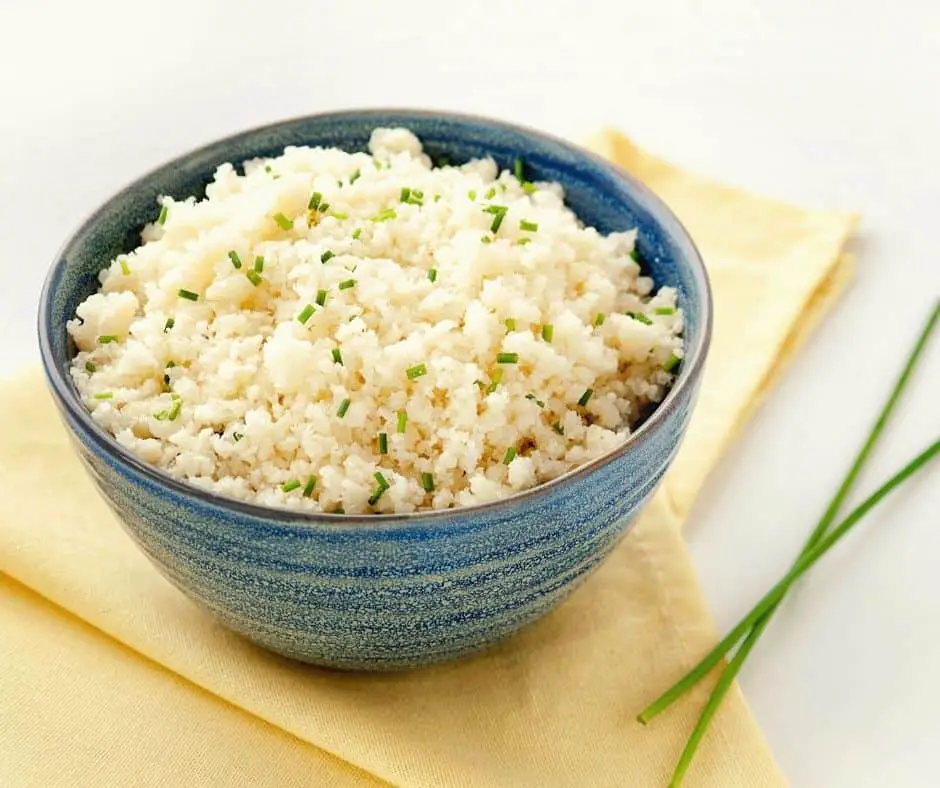
At first glance, cauliflower rice may look similar to white rice, but the two are very different in texture and taste.
Cauliflower rice tastes similar to cauliflower florets and is typically a cabbagey, nutty, mild flavor that some people describe as a little bitter; however, it does mellow out a lot when heated.
Unlike grain rice, which is comparably neutral and bland, cauliflower rice will have its own flavor. Nevertheless, this flavor is mild enough that you can season it to mask the cauliflower taste.
I will cover some good seasoning options below.
How To Season Cauliflower Rice?

Thanks to this veggie’s mild taste and versatility, there are many ways to season cauliflower rice. Popular options include:
- Grated Parmesan cheese (or vegetarian hard cheese alternative)
- Salt
- Fresh herbs (such as chopped parsley, chives, dill, basil, or cilantro)
- Sesame seeds
- Fresh lemon juice
- Coconut shavings
- Cayenne pepper
- Paprika
- Mixed Mexican spices
- Garlic, minced
- Soy sauce
- Chopped parsley
- Chopped nuts, raw or toasted (such as almonds or cashews)
- Additional drizzle of olive oil
- Chopped scallions
Why Choose Cauliflower Rice Over Regular Grain Rice?
Many people choose to swap grain rice for cauliflower rice in their diet, either as an entire swap or by incorporating both in a balanced diet.
The main reason cauliflower rice is so loved, especially in the weight loss community, is due to its low-calorie, high-fiber, and low-carbohydrate properties. Plus, it contains many vitamins, minerals, and antioxidants.
Cauliflower rice is suitable for those on the following diets:
- Keto
- Paleo
- Gluten-free
- Low carb
- Grain-free
- Dairy-free
- Sugar-free
- Vegan or plant-based
- or anyone trying to eat healthier.
Frozen cauliflower rice also cooks faster on the stove than grain rice, so it is a great option when you don’t have a lot of time.
You may also choose to mix it with regular rice to sneak in some extra vegetables. This is an excellent hack for any parents with fussy eaters looking for ways to up their children’s vegetable intake. Just be sure to season the mixed rice well to disguise the cabbagy taste.
Calories in Cauliflower Rice Vs. White Rice
Although calories shouldn’t be the sole deciding factor on the ‘worthiness’ of a food, cauliflower rice is sometimes favored due to being lower in calories (compared to cooked white grain rice).
In addition, due to the high fiber content, cauliflower rice can fill you up with fewer calories, curb your appetite and help you feel full longer.
One cup of cauliflower rice contains roughly 25 calories. Comparatively, cooked brown rice contains approximately 220 calories, and cooked white rice contains around 210 calories. [1]
Read Also: How To Rinse Rice? Do you even have to…
Conclusion
Now you can make golden and crunchy cauliflower rice from frozen that bursts with flavor. I recommend you cook with oil, but whichever method you choose will yield you a delicious side dish that can impress anyone. Also, don’t be afraid to experiment and try out some other cooking methods as well.
